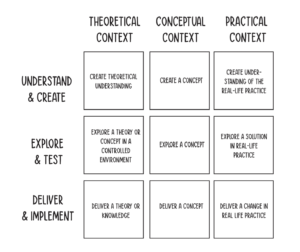Purpose: structure the research process by defining and achieving goals step by step
Who is it for: project managers, researchers
Technique: designing, group discussions, planning
Type of tool: implementation tool
Prior knowledge: little
Complexity: average
Time investment: days
Downloads
Links
About the tool (in Dutch)
Gerelateerde tools
What is the Research Pathway Model?
The purpose of the Research Pathway Model (RPM) is to gain insight into a research pathway: the research path to be taken by a research project or programme. The research path consists of the research steps and activities to achieve research goals. RPM is instrumental in exploring and articulating the many different goals of the partners involved and the different ways they envisage of achieving the project goals.
The model consists of two axes (see figure): a horizontal axis with three different research contexts and a vertical axis with three different research activities. The three research contexts are:
- The theoretical context, which focuses on creating, exploring and delivering a better understanding of issues and related solutions in theory or in a space – separated from real-life practice – such as a laboratory.
- The conceptual context, in which presupposed solutions are translated into a more specific prototype that is created, explored, produced and delivered. In this context, researchers, project partners and other stakeholders contribute knowledge (including experiential knowledge) to develop a concept together with the consortium and with or without the end users, but always in a defined space such as a brainstorming room, a pilot environment, or in the context of a pilot in an organisation.
- The practical context relates to the world of professional practice and/or the living environment of end users.
The three research activities are:
- Understand & Create, which refers to research goals aimed at creating greater understanding of the problem and finding the solution. Examples of research activities include conducting a literature review (create theoretical understanding), co-designing a prototype (create a concept), observing end users in their own context (create understanding of the real-life practice).
- Explore & Test, which refers to research goals with respect to exploring an idea, concept, construction or solution by performing research activities. Examples include laboratory research and testing in a controlled environment (explore a theory or concept in a controlled environment), evaluating a prototype in a pilot (explore a concept), and testing a prototype in the end-user environment (explore a solution in real-life practice).
- Deliver & Implement, which refers to research goals about delivering and implementing insights, products, services or processes during the research process. Examples include publishing research papers, an infographic or policy report (deliver a theory or knowledge), delivering a prototype (proof of concept) to developers or to a subsequent research project (deliver a concept) and working on an implementation strategy in an organisation (deliver a change in real-life practice).
Together, these two axes form a three-by-three matrix comprising nine steps. Each step represents a particular type of research step in a particular context. The matrix does not prescribe an ideal sequence of steps. The resulting pathway could very well be an iterative process in which a specific square appears in different steps of the process. The RPM can be used as a process model to identify activities and patterns and the relationship between them.

How do you use the RPM?
Using the RPM as a process model allows researchers to design their research pathways in advance. Moreover, it can help to revisit the research pathway during the course of the research and substantiate deviations from the original plan if necessary. RPM also supports evaluation and/or retrospective mapping of which activities led to which results. This can help determine what the next steps should be. The matrix makes it possible to identify the activities that contribute to implementation of the research project, where contributions to real-life practice and the conceptual and theoretical contexts can be made explicit.
In addition to the model itself, a conversation tool has also been developed. For DRIVE 2021, the Research Pathway Tool was developed using the Research Pathway Model (RPM, Van Beest et al., 2021). The tool allows researchers to plan, discuss or evaluate a research path with their partners, or in other words to have the conversation about the direction of the research, the methods and the returns (or continuous effects) for each partner during and after the research.
The RPM and tool provide insight into:
– What all parties have in mind with this project;
– What goals (including shared goals) you are pursuing;
– What activities (including research activities) you will carry out;
– In what order you want to achieve the set objectives:
– Who wishes to be involved in which research step.
What is the origin of RPM?
The RPM model was created after a retrospective study at Utrecht University of Applied Sciences (HU). A Dutch version of the Research Pathway Model (RPM) – the PRO model or PRraktijkgereidheid van Onderzoek Model – was developed in a previous research project (Van Beest, Balje and Andriessen 2017) as a domain-transcending conversation model to discuss the readiness of research projects for practice before, during and after the project. The early version of the RPM used Technology Readiness Levels (TRL) as a structuring tool (Mankins 2009). TRL is designed to assess the readiness of a given technology from the conceptual stage to implementation. TRL indicates the grade of a technology in nine levels, with TRL 1 representing a technology at the beginning of development and TRL 9 representing a technology that is technically and commercially ready for scale-up. The main difference between TRL and the RPM is that TRL is a linear model with nine levels, while the RPM is a process model in a matrix without a predetermined sequence of activities.



